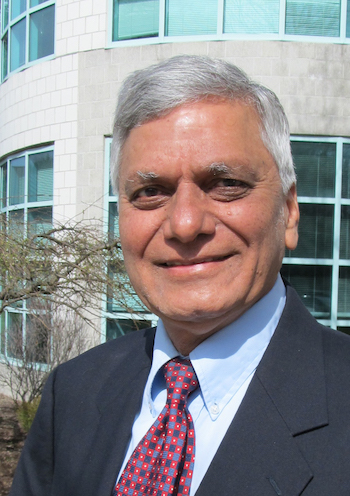
Arun Varshneya
This Symposium honors Professor Arun K. Varshneya—educator, mentor, scholar, and entrepreneur. Dr. Varshneya, Emeritus Professor of Glass Science and Engineering at Alfred University and president of Saxon Glass Technologies has dedicated nearly six decades of his life to the advancement of glass science, engineering, and technology. Born in Agra, India, Arun stands on the shoulders of the late Professor Ronald W. Douglas of Sheffield University (UK) for his undergraduate education and of the late Professor Alfred R. Cooper of Case Western Reserve University for his graduate education. Since his first technical presentations at the American Ceramic Society Annual Meeting in 1966 and at the International Congress on Glass in 1968, he has become one of the more recognized faces among global glass professionals. Varshneya’s leadership as an educator, mentor, scholar, and entrepreneur is clearly exemplified by many of the achievements that have paved the path for the future generations of glass scientists and engineers worldwide.
As an educator, or “Glass Guru,” Varshneya is best known for his textbook, Fundamentals of Inorganic Glasses, soon to appear in its third edition. The book combines a rigorous approach to glass science and technology with an accessible writing style, making it an ideal textbook for both upper-level undergraduates and graduate students. In addition to Alfred University, he has taught short courses on glass science and technology in many countries across the globe. He is a very engaging lecturer whose passion for glass science is truly contagious.
As a scholar, Varshneya and his students have worked and published on topics covering almost every physical property of glass, glass making, and processing. It is no surprise that Encyclopedia Britannica invited him in 1998 to be the guest author of a 13-page entry on “Industrial Glass.” He also has around 150 publications.
As an entrepreneur, Varshneya is a co-founder and president of Saxon Glass Technologies, a company that converts his science and technology of glass chemical strengthening to useful products that benefit mankind. Early development of the strengthening of cell phone display covers was actually conducted at Saxon Glass and Alfred University. The main product of the company, however, is the chemically strengthened borosilicate glass cartridge for the EpiPen, an auto-injection device delivering epinephrine antidote to prevent anaphylactic shock in people suffering from severe, life-threatening allergies. Before
Varshneya’s involvement, the EpiPen device suffered from an unacceptably high glass fracture rate during administration. With a carefully controlled process, failure of critical medicine delivery due to glass fracture has virtually disappeared in the over quarter billion number of products sold during the past 20 years.
Varshneya and his wife, Darshana, are also well known for their philanthropy, both locally in Alfred, NY, and throughout the broader glass and ceramics community. They often extend welcome with open arms to guests from overseas visiting Alfred University.
Varshneya has spent countless hours furthering the mission of The American Ceramic Society, the Society of Glass Technology, and the International Commission on Glass. His honors include Distinguished Life Member and Fellow of The American Ceramic Society, Fellow of the Society of Glass Technology, and President’s Award from the International Commission on Glass.
This symposium honors the lifetime contributions of Professor Varshneya, which have had a profound impact on many facets of glass science and technology and, more importantly, on the people throughout the glass community worldwide. This one-day symposium will consist of invited and contributed talks on topics that have influenced significant advancements based on his work. These topics may include: Fundamental glass science and technology, structure–property relationships, modeling of glass structures, glass strengthening and stronger glass products, glass-to-metal sealing, chalcogenide glasses, and glass education. In addition, light-hearted, brief anecdotal reflections may also be entertained.
Read the Festschrift in PDF and e-book formats!
Lead Organizer
- John C. Mauro, The Pennsylvania State University, USA, jcm426@psu.edu Vijay Jain, Savannah River Remediation, USA, Vijay.Jain@srs.gov
